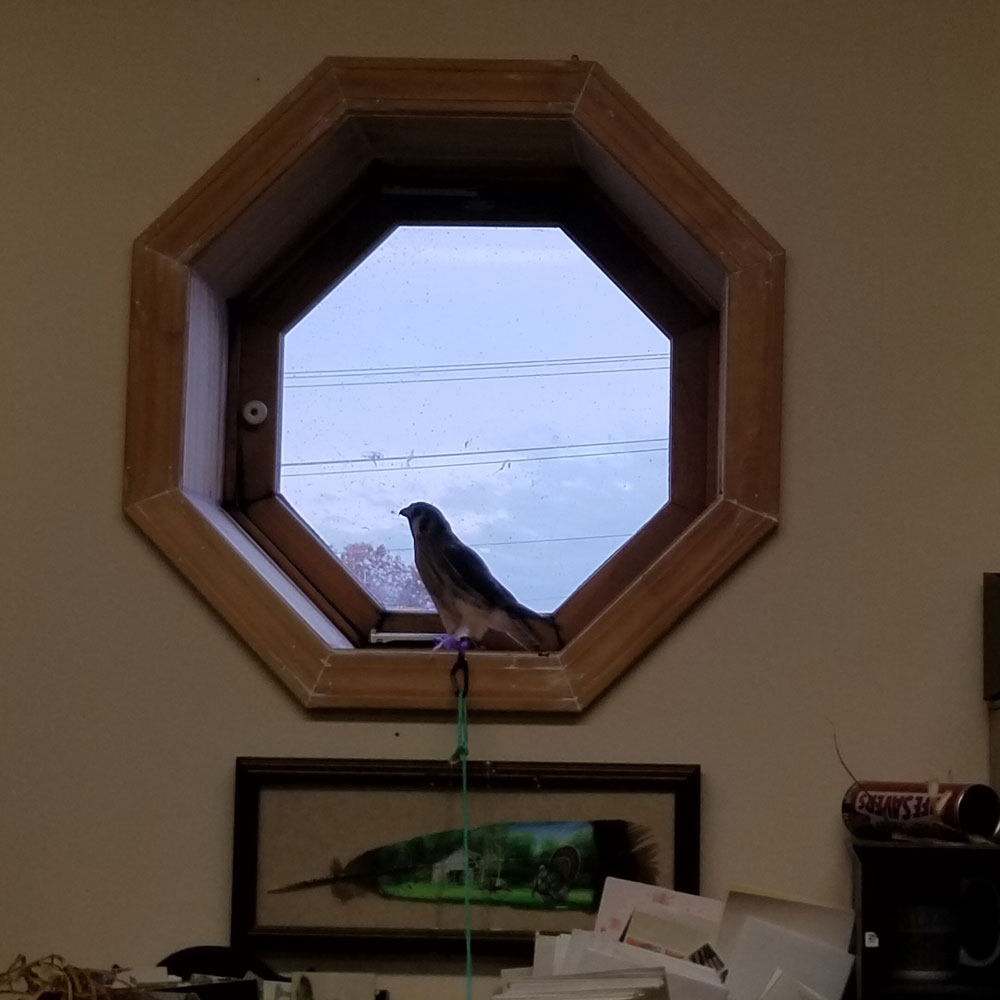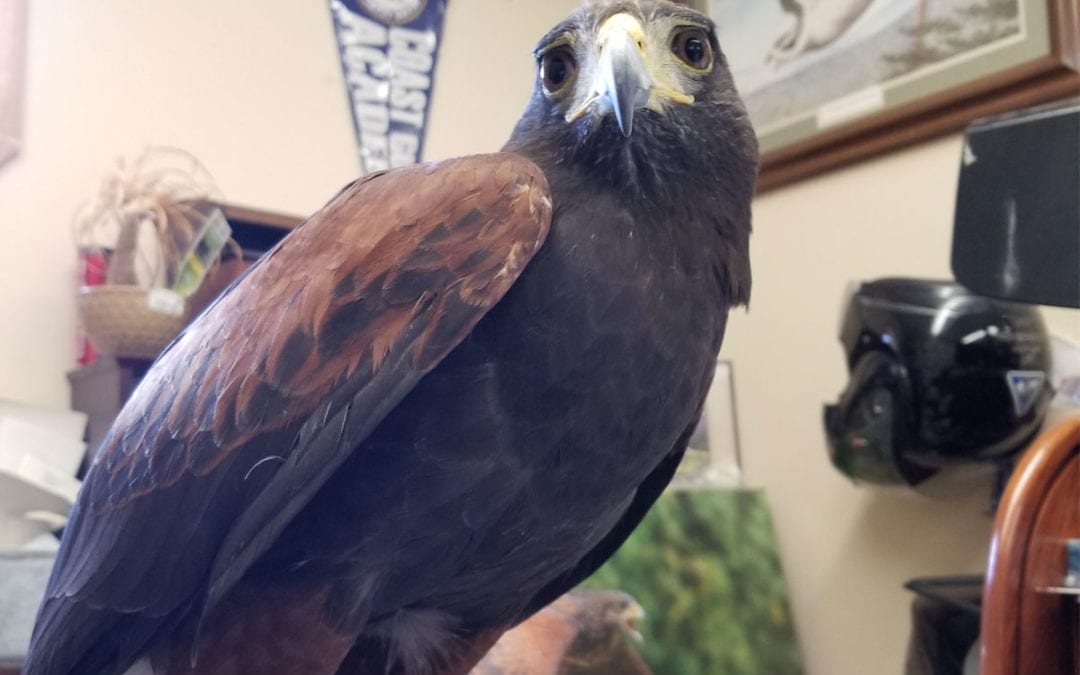Falconry is known as the sport of kings. I don’t think it was the true expense of the sport, but rather the vast amount of time that is needed to practice falconry or hawking. I am finding that challenging. Falconry is the use of conditioned, trained bird of prey to hunt wild animals. Technically a falconer flies a falcon and an Austringer flies a hawk or eagle. Hawking has taken on some negative connotations, (think pushy sales people) so many use the word falconer/falconry for all trained birds of prey hunters. Traditionalists may still insist on the original meaning.
 Falconry is a worldwide practice. Traditionally a northern goshawk or peregrine falcon is flown. Although in both North America and the UK the Harris hawk and red-tailed hawk are likely more widely used. Eastern European falconers prefer the northern goshawk and the golden eagle. In the Middle East, the saker falcon is the most traditional species flown. Falconry remains an important part of the Arab heritage and culture.
Falconry is a worldwide practice. Traditionally a northern goshawk or peregrine falcon is flown. Although in both North America and the UK the Harris hawk and red-tailed hawk are likely more widely used. Eastern European falconers prefer the northern goshawk and the golden eagle. In the Middle East, the saker falcon is the most traditional species flown. Falconry remains an important part of the Arab heritage and culture.
In the US, falconry requires a state permit that is issued under federal guidelines. To get a falconry license, you must pass a written test and have your equipment and facilities inspected. In order to get your permit, you must line up a sponsor and then and serve a minimum of two years as an apprentice under this licensed falconer. An apprentice falconer may only possess one raptor. After the two years and the recommendation of your sponsor, you can move up to a General Class license. A general falconer can have up to three raptors at one time. After a minimum of five years at General level, falconers may apply for a Master Class license, which allows them to keep up to five wild raptors for falconry and an unlimited number of captively-produced raptors. Certain highly experienced master falconers may also apply to possess golden eagles for falconry.
In days of old, falconers had to make all of their gear. Now it can be purchased, but I think that takes away some of the bond. Still I was happy to buy several gloves to find one that I liked for each bird. A ghan glove is typically made of double layer buckskin. Anklets go on the ankles and the jesses (tiny foot leashes) and bells attach. Bells help find your superbly camouflaged bird in case you were wondering. Bewits hold bells and transmitters. The leash attaches to the jesses and they glove or perch. Different birds need different types of perches. A lure helps convince the bird they want to return to you when you whistle. A creance is a very long leash for training when you don’t quite trust them. A mews is a small flight cage that must have a bath and perches. That is the minimum, but I seem to require much more. Hood blocks are useful for forming hoods. Desk perches, scale perches and outdoor perches all have uses.
In North America most beginner falconers start with a red-tailed hawk (RTH). A RTH is hardy and can be used on rabbits, squirrels and even geese, ducks, pheasants and perhaps turkeys. In our area, that usually means squirrels. We get several RTH’s that are brought in for wildlife rehab and some are trained in falconry techniques to work on their physical therapy. We have a RTH that is building up leg muscles after a fractured leg. While he will probably only be here 6-12 weeks, he takes time and currently must be hand fed.
American kestrels are the other ‘beginner’ bird, although they are anything but! I’ve worked with several species, and Focus, my kestrel, has the most attitude and has been the hardest to train. Kestrels are the smallest North American falcons and their size makes them fragile and they can easily die if neglected. Kestrels hunt small birds (starlings and sparrows) but can also be used for hunting large flying insects.
Harris Hawks live out west, so this is my first year working with a Harris Hawk. I have a female and a young male on his way. They are popular because of a good temperament and ability to take a wide variety of prey. They are social hunters and hunt as a pack. That means they will bond to the falconer. My female is starting to bond to me. My falconer partner picked her up today and she footed him several times. I took her and she stood quietly, but still seemed to glare at him from my glove. The social hierarchy is more similar to wolves than a flock. Harris Hawks are native to southern Texas and Arizona, but many are captive bred. Very adaptable, they can be used with car hawking where the raptor is launched from the window of a moving vehicle at suitable prey.
Accipiters are the true hawks and include goshawks, Cooper’s Hawks, Sharp-shinned and European sparrowhawk. They are fierce birds. “The attack of the accipiters is extremely swift, rapid and violent in every way.” They are used in falconry use both in Europe and North America. I know from rehab, the Sharp-shinned adult can stress easily in captivity.
The larger falcons are required to be captive bred for falconry. Declining populations meant regulations that limited or prohibited peregrine trapping. Prairie falcons, gyrfalcons, lanners, sakers and merlins are used in falconry. The falcons tend to be used more for bird prey.
Owls are technically not the art of falconry, but the training techniques have been adapted for the Eurasian eagle owl and the great horned owl. Training relies much more on hearing than on sight and requires quite a bit of patience.
Eagles are used in other parts of the world and rarely in the US. Perhaps five golden eagle permits were released last year in the US to master falconers. In Kazakhstan, eagles are used to hunt foxes, and other large prey. Eagles primarily hunt over large open ground and present potential danger to other people if hunted in a widely populated area. Plus they are difficult to train and manage.
Actually after a sharp scalp massage, Focus moved back to her window perch. If there was any question, she definitely is annoyed with me. I’m not sure what I’ve done. Too much or too little attention and probably too much food, since she leaves quail bits unattended on her perch. Still we are bonding as I write and that is a good thing for training. Soon we will be in the field.

